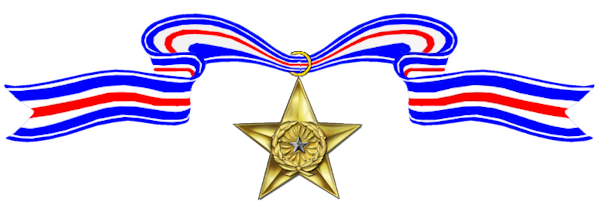The President of the United States of America takes pride in presenting a Silver Star in lieu of a Sixth Award of the Distinguished Flying Cross (Posthumously) to Commander William Henry Searfus (NSN: 0-552944), United States Navy, for heroism and extraordinary achievement while participating in aerial flight on 24 October 1967, as Commanding Officer of Attack Squadron ONE HUNDRED FIFTY-FIVE (VA-155), embarked in U.S.S. CORAL SEA (CVA-43). Commander Searfus led eight strike aircraft comprising the second element of a major air-wing assault on the strongly defended and previously un-struck Phuc Yen airfield in North Vietnam. When his element was taken under attack by an onslaught of deadly surface-to-air missiles, he skillfully maneuvered to avoid the danger, calmly assessing the situation, alerting his element to the threat, and pressing on to the target. After placing his element over the airfield in an optimum position for a bombing attack, Commander Searfus discovered that his pre-planned aim point was obscured by cloud cover, but elected to circle this perilous area until a satisfactory tactical position could be located. Despite the intensified enemy anti-aircraft fire concentrated within the open area, he alerted the element of his intention to attack, and flawlessly executed a devastating dive-bombing assault that resulted in multiple cuts on the vital taxiways of the airfield and heavy damage to the revetments. After the attack, and during continual assault by enemy defenses, he successfully guided his element to a safe retirement. Commander Searfus’ intrepidity, courage, and unexcelled marksmanship in the face of intense hostile fire were in keeping with the highest traditions of the United States Naval Service.

Awards Received
-

Silver Star
-
Silver Star
Service:
United States NavyRank:
CommanderBatallion:
Attack Squadron 155 (VA-155)Division:
U.S.S. Coral Sea (CVA-43)Action Date:
October 25, 1967
CNO Letter Serial 1542P09B1 (April 25, 1968)The President of the United States of America takes pride in presenting the Silver Star (Posthumously) to Commander William Henry Searfus (NSN: 0-552944), United States Navy, for conspicuous gallantry and intrepidity in action on 25 October 1967, as Commanding Officer of Attack Squadron ONE HUNDRED FIFTY-FIVE (VA-155), embarked in U.S.S. CORAL SEA (CVA043). Commander Searfus led two divisions of strike aircraft comprising the lead element of a major air-wing assault on the strongly defended Phuc Yen airfield in North Vietnam. Flying over heavily defended enemy terrain, he led his strike element in cleverly calculated evasive maneuvers which confused and deterred the enemy. When tracked on three different occasions by surface-to-air missiles, he assessed each situation, alerted the force to the threat, and pressed on to the target. After reaching the target and placing his elements in optimum tactical positions, he commenced his dive only to observe two more surface-to-air missiles heading toward the attacking aircraft. Alerting the group to this new threat, Commander Searfus unhesitatingly performed a devastating dive-bombing run on the assigned target, completely destroying it. During the recovery phase of his attack, he was engulfed by withering enemy anti-aircraft fire which actually displaced his aircraft but, quickly regaining control, he selected an egress route which led to a safe retirement. Commander Searfus’ courage, dynamic leadership, and determination in the face of intense enemy opposition reflected great credit upon himself and upheld the highest traditions of the United States Naval Service.

